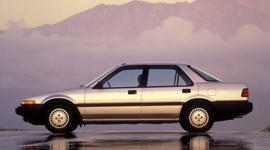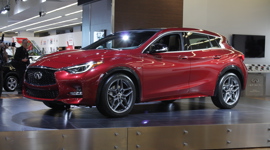
The Insurance Institute for Highway Safety (IIHS), the folks who bring us Top Safety Pick awards, the new small overlap frontal test, and have been working to improve auto safety since 1959, have just released a new safety test and new rankings. This time, it's a look at headlights and how effective they are. North American headlight standards have remained largely unchanged since the change from sealed beam to composite lights in the mid 1980s, and have not completely caught up with advances like HID bulbs, LED lamps and lights that can turn to follow the steering. The IIHS recognized that nighttime accidents are largely caused by poor visibility, so they set up a test of headlight systems to rank good from bad. The test was set up to rank visibility from low and high beams in a straight line, in gradual left and right turns and in sharp left and right hand turns. Real collision data was used to assign a weight to the performance in each test. IIHS engineers then subjectively compared glare caused by each vehicle to oncoming drivers and visibility from the headlights to that of a hypothetical ideal lighting system. Low beams were weighted more heavily in the testing as they are the most frequently used.
IIHS tested 31 midsize 2016 model year vehicles, and found only one to be ranked as good, with 19 ranked as marginal or poor. That lone good car was the Toyota Prius V, when equipped with LED lights and high beam assist. The Prius V tested with regular halogen bulbs received a poor rating. The difference between the two is shocking. At 110 km/h, the LED equipped Prius V was able to see and identify an object in the road with sufficient time to stop. The non LED Prius V would need to be travelling only 80 km/h in order to stop safely for the same obstacle. The LED Prius V low beam lights allowed the driver to identify an obstacle 122 metres in front of the car. The worst in test BMW 3-series (when equipped with halogen bulbs) illuminated only 40 metres ahead. That means the driver would only be able to safely stop at a speed of 57 km/h. The 3-series equipped with corner following LED lights scored a slightly better marginal rating.
Other vehicles scored well for visibility, but lost points for causing glare for oncoming vehicles. The Kia Optima was tested with three headlight configurations, halogen reflector, halogen projector and HID projector. All three scored well for visibility with both styles of halogen lights being within half a metre of each other at 91 metres, and the HID version at 112 metres, but all three scored a poor rating due to causing unacceptable glare for oncoming traffic.
The technology in the light was not always a deciding factor either. The Honda Accord with halogen projectors scored an acceptable rating with the LED projector model scoring a worse marginal rating. The Cadillac ATS, Kia Optima and Mercedes C-class all received poor ratings when equipped with adaptive high and low beams.
The IIHS reached two interesting conclusions with this test. The first was that high beams make a massive difference, but that drivers don't use them as much as they should. They found that in observations of 3,200 isolated vehicles (vehicles that should be using high beams) that in some areas high beam use was less than one percent of ideal. Even on unlit rural roads, high beam use was less than half. For this reason the IIHS weighted cars with high beam assist more highly than those without, as the visibility in many cases was improved by more than 25%.
The second was that, as per IIHS Senior Research Engineer Matthew Brumbelow, "many headlight problems could be fixed with better aim". This was not elaborated on in the test report, and it was not clear if the IIHS tested to see if the test vehicles were within manufacturer's specifications. In response to a request for clarification of the test method the IIHS did not clarify if the aim was tested, but repeated that the vehicles were as they came from the dealer and that "based on our research prior to doing these tests, it’s likely that many would have improved ratings with better aim". The reason given for not checking or adjusting the aim was that "the burden shouldn’t fall on the consumer to figure out what the best aim is". Both Canadian and US federal regulations specify specific allowable brightness and many provinces and states require headlight alignment to meet certain specifications, so if the IIHS is going to do the test, they should verify the car meets that specification. Especially on something that they stress is an important factor that could significantly change results.
Which brings up an important issue. There are a few simple things you can do to maximize the lighting from the vehicle you have. Halogen bulbs dim over time, so if your bulbs are two years old they may have lost 20% or more of their original brightness. Consider replacing them with a quality bulb. Make sure to look for reputable brands and a DOT stamp as some, especially those advertising non-white light colours, do not meet provincial or federal lighting standards. The second is to look at the state of the headlight covers. If they are pitted or yellowed, they could be blocking much of the light. Consider a headlight refinishing kit, or ask a local detail shop if they can provide that service. A kit that provides a clear coat or UV protectant finish is important too as an uncoated refinished lens can yellow quickly. Finally, and possibly most importantly, check the alignment of your own lights. You can usually find the procedure in your owner's manual and you can find a guide to roughly check the aim here. If you aren't able to adjust them, your repair shop should be able to do this for you. This could mean the world some night on one of Canada's countless dark roads.




























